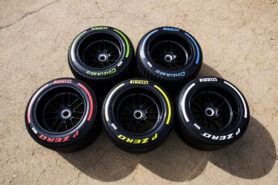Blistering

Pirelli tyre compounds during the Barcelona February testing at Circuit de Barcelona-Catalunya on Thursday February 24, 2022
Blistering is a common issue faced by Formula 1 teams during racing. It occurs when the tires start to overheat, leading to the formation of bubbles or blisters on the surface of the tires. These blisters can be a serious problem for teams, as they can greatly affect the performance of the car.
The cause of blistering is usually due to a combination of factors. One of the main causes is the high speeds and intense forces that the tires are subjected to during a race. The tires are constantly being pushed to their limits, which can cause them to overheat and blister. Another common cause is the use of the wrong tire compound. Different types of tires are designed to handle different conditions, and if a team uses a tire that is not suited to the track or weather conditions, it can lead to blistering.
The effects of blistering can be significant. The blisters on the tires can reduce their grip and increase their wear, which can make it harder for the drivers to control the car and slow them down. This can lead to a loss of time and positions on the track, which can be critical in a race. Additionally, blisters can make the tires more prone to failure, which can be dangerous for the drivers and the other racers on the track.
To prevent blistering, teams use a variety of strategies. One of the most important is to use the right tire compound for the conditions. Teams will also use different tire pressures and camber angles to try and reduce the heat on the tires. Additionally, teams will often make adjustments to the car's suspension and aerodynamics to help reduce the loads on the tires.











LAST 3 F1 Fan COMMENTS